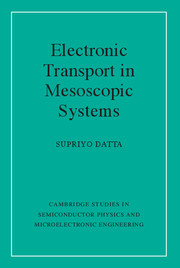Book contents
- Frontmatter
- Contents
- Acknowledgements
- A few common symbols
- Introductory remarks
- 1 Preliminary concepts
- 2 Conductance from transmission
- 3 Transmission function, S-matrix and Green's functions
- 4 Quantum Hall effect
- 5 Localization and fluctuations
- 6 Double-barrier tunneling
- 7 Optical analogies
- 8 Non-equilibrium Green's function formalism
- Concluding remarks
- Solutions to exercises
- Index
5 - Localization and fluctuations
Published online by Cambridge University Press: 05 June 2013
- Frontmatter
- Contents
- Acknowledgements
- A few common symbols
- Introductory remarks
- 1 Preliminary concepts
- 2 Conductance from transmission
- 3 Transmission function, S-matrix and Green's functions
- 4 Quantum Hall effect
- 5 Localization and fluctuations
- 6 Double-barrier tunneling
- 7 Optical analogies
- 8 Non-equilibrium Green's function formalism
- Concluding remarks
- Solutions to exercises
- Index
Summary
According to Ohm's law, the resistance of an array of scatterers increases linearly with the length of the array. This describes real conductors fairly well if the phase-relaxation length is shorter than the distance between successive scatterers. But at low temperatures in low-mobility samples the phase-relaxation length can be much larger than the mean free path. The conductor can then be viewed as a series of phase-coherent units each of which contains many elastic scatterers. Electronic transport within such a phase-coherent unit belongs to the regime of quantum diffusion which has been studied by many authors since the pioneering work of Anderson (P. W. Anderson (1958), Phys. Rev.109, 1492). In this regime, interference between different scatterers leads to a decrease in the conductance. For a coherent conductor having a overall conductance much greater than ~ (e2/h) or 40 μΩ-1, the decrease in the conductance is approximately (e2/h). Such a conductor is said to be in the regime of weak localization (Section 5.2). This effect is easily destroyed by a small magnetic field (typically less than 100 G), so that it can be identified experimentally by its characteristic magnetoresistance (Section 5.3). This is a very important effect, because unlike most other transport phenomena it is sensitive to phase relaxation and not just to momentum relaxation. Indeed the weak localization effect is often used to measure the phase-relaxation length.
- Type
- Chapter
- Information
- Electronic Transport in Mesoscopic Systems , pp. 196 - 245Publisher: Cambridge University PressPrint publication year: 1995
- 1
- Cited by



